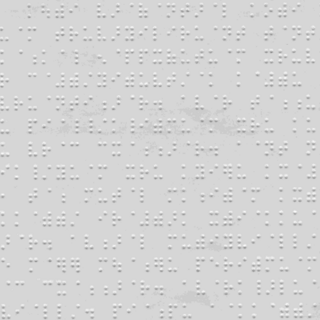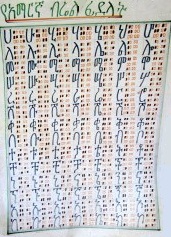
Hebrew Braille is the braille alphabet for Hebrew. The International Hebrew Braille Code is widely used. It was devised in the 1930s and completed in 1944. It is based on international norms, with additional letters devised to accommodate differences between English Braille and the Hebrew alphabet. Unlike Hebrew, but in keeping with other braille alphabets, Hebrew Braille is read from left to right instead of right to left, and unlike English Braille, it is an abjad, with all letters representing consonants.

Russian Braille is the braille alphabet of the Russian language. With suitable extensions, it is used for languages of neighboring countries that are written in Cyrillic in print, such as Ukrainian and Mongolian. It is based on the Latin transliteration of Cyrillic, with additional letters assigned idiosyncratically. In Russian, it is known as the Braille Script.

Bharati braille, or Bharatiya Braille, is a largely unified braille script for writing the languages of India. When India gained independence, eleven braille scripts were in use, in different parts of the country and for different languages. By 1951, a single national standard had been settled on, Bharati braille, which has since been adopted by Sri Lanka, Nepal, and Bangladesh. There are slight differences in the orthographies for Nepali in India and Nepal, and for Tamil in India and Sri Lanka. There are significant differences in Bengali Braille between India and Bangladesh, with several letters differing. Pakistan has not adopted Bharati braille, so the Urdu Braille of Pakistan is an entirely different alphabet than the Urdu Braille of India, with their commonalities largely due to their common inheritance from English or International Braille. Sinhala Braille largely conforms to other Bharati, but differs significantly toward the end of the alphabet, and is covered in its own article.
Greek Braille is the braille alphabet of the Greek language. It is based on international braille conventions, generally corresponding to Latin transliteration. In Greek, it is known as Κώδικας Μπράιγ Kôdikas Brég "Braille Code".
The goal of braille uniformity is to unify the braille alphabets of the world as much as possible, so that literacy in one braille alphabet readily transfers to another. Unification was first achieved by a convention of the International Congress on Work for the Blind in 1878, where it was decided to replace the mutually incompatible national conventions of the time with the French values of the basic Latin alphabet, both for languages that use Latin-based alphabets and, through their Latin equivalents, for languages that use other scripts. However, the unification did not address letters beyond these 26, leaving French and German Braille partially incompatible and as braille spread to new languages with new needs, national conventions again became disparate. A second round of unification was undertaken under the auspices of UNESCO in 1951, setting the foundation for international braille usage today.
Armenian Braille is either of two braille alphabets used for writing the Armenian language. The assignments of the Armenian alphabet to braille patterns is largely consistent with unified international braille, with the same punctuation, except for the comma. However, Eastern and Western Armenian are assigned braille letters based on different criteria. The conventions for Western Armenian were developed in Lebanon.
Dutch Braille is the braille alphabet used for the Dutch language in the Netherlands and in Flanders.
Italian Braille is the braille alphabet of the Italian language, both in Italy and in Switzerland. It is very close to French Braille, with some differences in punctuation.
Turkish Braille is the braille alphabet of the Turkish language.
Telugu Braille is one of the Bharati braille alphabets, and it largely conforms to the letter values of the other Bharati alphabets.
Punjabi Braille is the braille alphabet used in India for Punjabi. It is one of the Bharati braille alphabets, and largely conforms to the letter values of the other Bharati alphabets.
Gujarati Braille is one of the Bharati braille alphabets, and it largely conforms to the letter values of the other Bharati alphabets.
Odia Braille is one of the Bharati braille alphabets. Apart from using Hindi æ for Odia ẏ, it conforms to the letter values of the other Bharati scripts.
Kannada Braille is one of the Bharati braille alphabets, and it largely conforms to the letter values of the other Bharati alphabets.
Malayalam Braille is one of the Bharati braille alphabets, and it largely conforms to the letter values of the other Bharati alphabets.

Ge'ez Braille is the braille alphabet for all Ethiopic languages. Letter values are mostly in line with international usage.

Burmese Braille is the braille alphabet of languages of Burma written in the Burmese script, including Burmese and Karen. Letters that may not seem at first glance to correspond to international norms are more recognizable when traditional romanization is considered. For example, သ s is rendered ⠹th, which is how it was romanized when Burmese Braille was developed ; similarly စ c and ဇ j as ⠎s and ⠵z.
Several braille alphabets are used in Ghana. For English, Unified English Braille has been adopted. Four other languages have been written in braille: Akan (Twi), Ga, Ewe, and Dagaare. All three alphabets are based on the basic braille letter values of basic Latin alphabet:
The braille alphabet used for the Kyrgyz language is based on Russian Braille, with a few additional letters found in the print Kyrgyz alphabet.
The braille alphabet used for the Kazakh language is based on Russian Braille, with several additional letters found in the print Kazakh alphabet.




